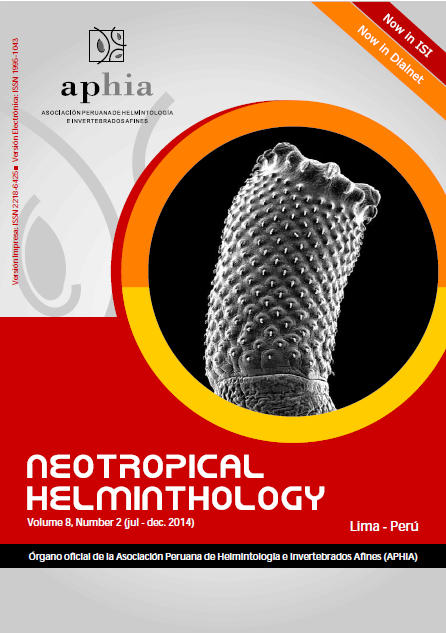EPIDEMIOLOGIC AND ZOONOTIC RISK OF THE MALACOFAUNA FLUVIALAND TERRESTRIAL IN CAPITÁN ROBERTO FLEITES HEALTH AREA, CUBA
DOI:
https://doi.org/10.24039/rnh201482924Keywords:
Cuba, environmental factors, epidemiologic risk, malacofauna, mollusc, richness of species, zoonotic.Abstract
The main objective was to identify the epidemiological and zoonotic risk of fluvial and terrestrial molluscs in the Health Area Roberto Fleites, municipality Santa Clara, Villa Clara province, Cuba. Snails were sampled monthly during 2011-2012. Mollusc species with greater frequency and distribution were Praticolella griseola, Tarebia granifera and Pseudosuccinea columella. The most medically important species were: P. griseola, Physella columella, Subulina octona, Physa acuta, Pomacea poeyana and Galba cubensis that are intermediate hosts and transmitters of parasitic helminth diseases. A greater abundance of molluscs in orchards organoponic in relation to bodies of water sampled was observed; however, higher species richness of molluscs was obtained in water bodies in the orchards-organoponics. There is an increased epidemiological risk-in organopónicos orchard, where 96.49% of molluscs are capable of transmitting disease to man and animals, while in the bodies of water, only 8.32% of the mollusks are capable of transmitting diseases to man and animals. Asignificant relationship between the mollusc and the maximum relative humidity and precipitation was evident.
Downloads
Published
How to Cite
Issue
Section
License
Copyright (c) 2021 Neotropical Helminthology

This work is licensed under a Creative Commons Attribution-NonCommercial-NoDerivatives 4.0 International License.
OBJETO: El AUTOR-CEDENTE transfiere de manera TOTAL Y SIN LIMITACIÓN alguna al CESIONARIO los derechos patrimoniales que le corresponden sobre la (s) obra(s) tituladas: xxxxxxxxxxxxxxxx, por el tiempo que establezca la ley internacional. En virtud de lo anterior, se entiende que el CESIONARIO adquiere el derecho de reproducción en todas sus modalidades, incluso para inclusión audiovisual; el derecho de transformación o adaptación, comunicación pública, traducción, distribución y, en general, cualquier tipo de explotación que de las obras se pueda realizar por cualquier medio conocido o por conocer en el territorio nacional o internacional.
REMUNERACIÓN: La cesión de los derechos patrimoniales de autor que mediante este contrato se hace será a título gratuito.
CONDICIONES Y LEGITIMIDAD DE LOS DERECHOS: El AUTOR-CEDENTE garantiza que es propietario integral de los derechos de explotación de la(s) obra(s) y en consecuencia garantiza que puede contratar y transferir los derechos aquí cedidos sin ningún tipo de limitación por no tener ningún tipo de gravamen, limitación o disposición. En todo caso, responderá por cualquier reclamo que en materia de derecho de autor se pueda presentar, exonerando de cualquier responsabilidad al CESIONARIO.
LICENCIA DE ACCESO ABIERTO: El AUTOR-CEDENTE autoriza que manuscrito publicado en La Revista Neotropical Helminthology permanece disponible para su consulta pública en el sitio web https://www.neotropicalhelminthology.com/ y en los diferentes sistemas de indexación y bases de datos en las que la revista tiene visibilidad, bajo la licencia Creative Commons, en la modalidad Reconocimiento-No comercial- Sin Trabajos derivados –aprobada en Perú, y por lo tanto son de acceso abierto. De ahí que los autores dan, sin derecho a retribución económica, a la Asociación Peruana de Helmintología e Invertebrados Afines (APHIA), los derechos de autor para la edición y reproducción a través de diferentes medios de difusión.


 Numero 2 Volumen 19 - 2025 (versión Anticipada)
Numero 2 Volumen 19 - 2025 (versión Anticipada)














































